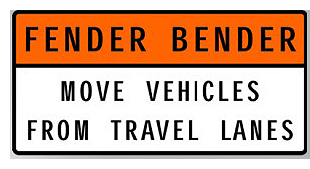
Clearing crashed vehicles even more important
during winter driving conditions
It's not just the crash that can be serious, but also how long it remains on the road.
The Quick Clearance law, adopted in 2005, requires drivers to move obstructions off the road quickly and safely in the event of a crash. Unless the crash results in death or injury, a damaged vehicle must be moved if it is not disabled, does not require towing, can operate under its own power and can be safely driven. This allows emergency responders and law enforcement the space to safely do their jobs. It also improves safety and traffic flow.
With the advent of winter driving conditions and slick roads, clearing a crash off the highway before it leads to tragedy is critical.
 Why is it important to clear your crash?
Why is it important to clear your crash?
Some collisions, called secondary crashes, cn occur as the result of a previous crash. About 20 percent of all crashes are secondary.
"The longer the first crash remains in the roadway, the greater the chance of a secondary crash," explained Cpt. Brian Zimmerman of the Idaho State Police.
For each minute a crash is not cleared, the chances of a secondary crash increase by about 3 percent. By this measure, each half hour a crash is not cleared almost doubles the chances of another crash.
Protect those who protect you
Sometimes emergency responders, law enforcement officers and ITD maintenance personnel become victims in these secondary crashes.
Clearing the highway following a minor crash and giving emergency responders plenty of room significantly reduces the chance that another collision will occur. By minimizing exposure to passing traffic, it also becomes a safety measure for victims or witnesses. For all of those reasons, most states have some version of a "Quick Clearance" or "Move It" law.
For every minute a lane is closed, especially an interstate lane, it takes several minutes for traffic to recover and resume flowing freely.
Closed travel lanes cause significant congestion and cost Idaho businesses and employees thousands of dollars in missed work time and productivity. Added business expense also is incurred, as well as an increase in fuel consumption and emissions that reduce air quality.
The law applies primarily to interstates, controlled access and major divided highways, but allows a crash on any highway to be removed if it obstructs traffic. Signs along the highway help clarify where the law applies.
"The law will not interfere with law enforcement’s duty to investigate crashes or enforce criminal, traffic or highway laws," Zimmerman said. "Officers have the authority to require removal of vehicles or debris from freeway travel lanes."
Drivers should do this whether or not a law enforcement officer is on the scene .Motorists should always follow the directions of law enforcement officers if they are on the crash scene.
ITD’s Incident Response crews assist law enforcement in clearing crash scenes along Interstate 84 in the Treasure Valley.
Published 12-2-2011